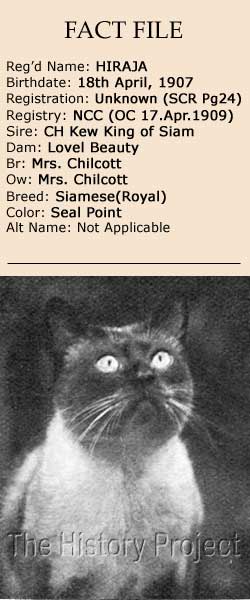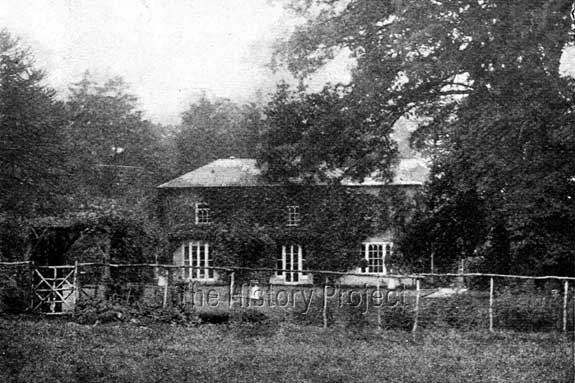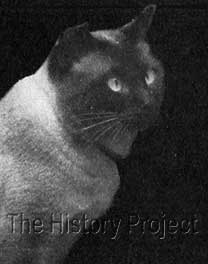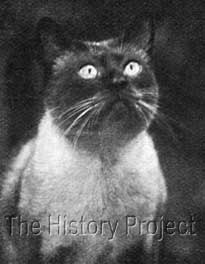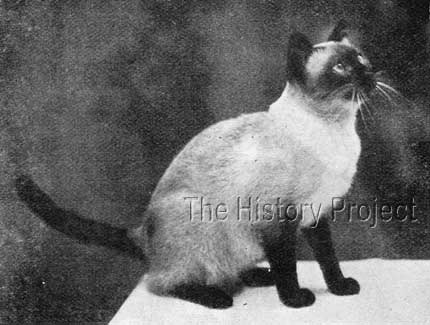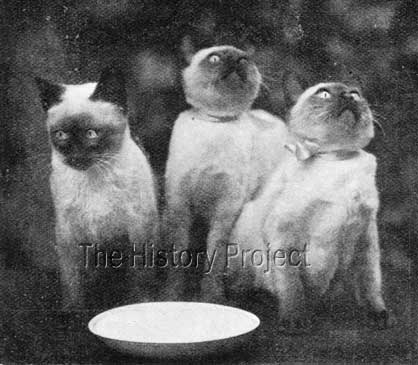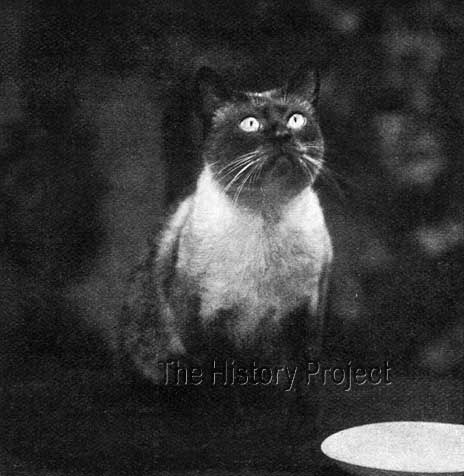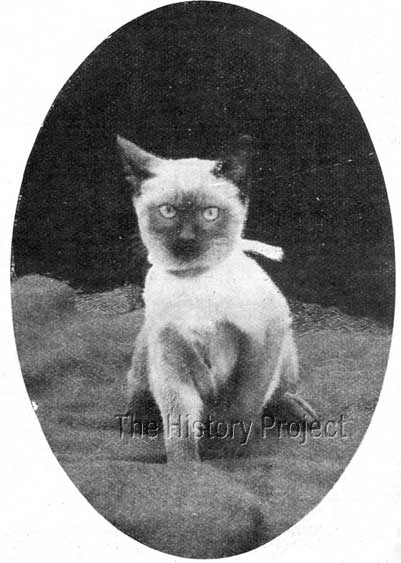 | |||||||||||||||||||









|
HIRAJA (1907)PHOTOS | SOCIAL MEDIA | REFERENCES
HISTORICAL BACKGROUND:By the first decade of the twentieth century, the Siamese cat as a breed, had a firm hold in the world of pedigreed cats; and there was considerably more diversity in the gene pool due to an ever increasing number of imports from the orient. The number of breeders also increased as cat fanciers of all persuasions, add Siamese to their retinue of breeds. The first specialist Club for Siamese was inaugurated in 1900. Very few breeders specialised in a single breed, but were drawn initially into the world of cats by their natural fancy for one type, then by being introduced to other varieties were often persuaded to try their hand at a second or third variety. Mrs. Chilcott of 'Lovel Dene', in Windsor Forest, was no exception to this general rule. While it appears as though her primary love may have been Siamese, a breed in which she had considerable success; she is also known to have owned and bred Persians. Miss Frances Simpson records an instance in an article she wrote about Mrs. Chilcott's cats for 'The Queen' magazine in November of 1908: "Mrs. Chilcott possessed a great pet in 'Joan', who began life as a black cat, but turned into a decided smoke. She was mated to 'Blue Boy III', and had a lovely little smoke kitten, which was entered at the last Westminster Cat Show, where it took high honours and was sold to Dr Prior. When 'Joan' the mother died, Mrs. Chilcott approached Dr Prior with a view to buying back little 'Pearl', and succeeded, this orange-eyed smoke now being the mother of three blues and a smoke. One blue, according to an arrangement, gone to Dr Prior, and the other two, are big fat kittens, tearing about the garden at 'Lovel Dene'. A black Persian neuter getting on in years is allowed the run of the house, and Pansy, a lovely blue female litter sister to 'Pearl', is a specimen that Mrs. Chilcott may well be proud of having bred."3 But it was her foundation females, specifically 'Lovel Beauty' (SCR:V1)¹ and 'Kim' (SCR)1 who helped set her on the map, with her Siamese. 'Lovel Beauty', who was born in May 1904, would become the dam of a number of successful 'Lovel' Siamese cats and kittens, not the least of which was her male 'Hiraja'(SCR:V1)1; while 'Kim' (for whom we can trace no specific heritage), was the dam of 'Ananda' a seal-point Siamese whom Mrs. Chilcott exported export to the United States, where she was registered as 'Romeo Ananda (Imp)', (CFA:361)4, by Mrs. Dykhouse, of Grand Rapids, Michigan.
PARENTAGE & OWNERSHIP:
Cairo Ramses, seal point
ENG CH Kew King of Siam, seal point
| Zimmie, seal point
Hiraja, Apr-18-1907, seal point Siamese
| Tiam O'Shian IV, seal point
Lovel Beauty, seal pint
Unknown
When 'Hiraja' a Seal-point (Royal Siamese) male was born 18th April, 1907; he had three immediate claims to fame. The first was that his sire was the immensely popular Seal-point male 'Champion Kew King of Siam',(NCC: 272a/v6)6 owned by Mrs. F. Norris who, at that time, was one of the most sought after Siamese stud males in the United Kingdom. The second was, that as a son of 'Ch. Kew King of Siam', he was a sire-sibling to a rising star in the world of Siamese, which was 'Champion Sancho', (NCC: 562/v5)6 bred by Mrs. de Vere Brooke and owned by Miss C. Cochrane. It is distinctly possible, that Mrs. Chilcott, upon laying eyes on the extremely promising young 'Sancho', may have been persuaded to breed her 'Lovel Beauty' to his sire in an attempt to breed a male of similar quality. Certainly, by comparing the two, there are distinctive similarities of style between both 'Sancho' born in 1906, and her own 'Hiraja', born in 1907. The third claim was due to the successes of his dam's progeny from a litter born earlier that year from a breeding to 'Malachite Togo', and the fact that 'Lovel Beauty' was herself sired by none other than 'Tiam O'Shian IV', who traced his ancestry through a double on 'Tiam O'Shian III' back to some of the earliest and best Siamese seen in England from Mrs. Vyvyan's original strain.
Mrs. Chilcott lived with her husband at 'Lovel Dene',and Miss Simpson elaborates for us in an article about Mrs. Chilcott's cattery published in The Queen: "In a charming corner of Windsor Forest, between Ascot and Bracknell, Mr. & Mrs. Chilcott reside in an old-fashioned house surrounded with glorious oaks and beeches, which at the time of my visit were beautiful with autumn tints. Mr. Chilcott is an owner and breeder of thoroughbred horses, and Mrs. Chilcott from being a great cat lover has recently become an ardent fancier. It is chiefly as a successful breeder of Siamese that she has made herself famous in the cat world, and she owns a fine pair of this fascinating and curious variety. Hiraga [sic], the male, has a splendid cattery, with wired-in run, at some distance from the house, as his voice is not "low and sweet," and Lovel Beauty, the female, had a family of five beautiful and promising kittens at the time of my visit. They were clambering up the netting of their cattery, and I greatly admired their marvellously bright blue eyes."3 SIBLINGS & SHOWS:Due to the popularity of his sire 'Champion Kew King of Siam', 'Hiraja' had numerous sire siblings, not least among them, being Miss C. Cochrane's 'Champion Sancho' who was born in September, 1906. Other better known sire siblings included Miss Meriel Taylor's 'Maimoune'(SCRv1)1, (aka 'Malachite Maimoune') a daughter of 'Kew King of Siam' out of 'Princess Tuli'; Lady Decies 'Fulmer King Krom',(OC:22/Feb/1908)7,out of Miss Aubertin's 'Phya II'(SCRv1)1; who was herself also sired by 'Ch. Kew King of Siam'.
included 'Southampton Buddha', a female owned by Mrs. Allen Maturin, and the male 'Romeo Ananda',(CFA:361)4, bred by Mrs. Chilcott herself a year earlier, out her Siamese foundation queen 'Kim' to 'Kew King of Siam' and exporting this male to Mrs. Dykhouse of the 'Romeo' cattery in Michigan. Of Dam siblings, we have the following information, taken from the only three known litters we knowledge of thus far, out of Mrs. Chilcott's 'Lovel Beauty'. The first litter was that which produced 'Hiraja' on 18th April, 1907. The second appears to have been from a breeding to 'Malachite Togo'(SCRv1)1, in a litter born 21st April, 1908. This is the older litter alluded to in Miss Simpson's commentary about her visit to Mrs. Chilcott's property in November of that year, which included the female 'Princess Malachite'(SCRv1)1,the neuter 'Tommy'3, and another male named 'Dromens'.
"A beautiful young female of Lovel Beauty's last litter, called 'Princess' has already done some winning in the show pen, and 'Tommy' her litter brother, is well-nigh a perfect specimen-too good, many would assert, to have been made a neuter pet. He is the spoilt darling of his devoted mistress, and lay contendedly on the drawing-room hearthrug. He, however, roams at will, for Mrs. Chilcott does not believe in coddling her pets, the litter of Siamese being born out of doors,and they continue to thrive splendidly in their comfortable cattery, despite chilliness of autumn."3
The third litter of record from 'Lovel Beauty', was that born on 11th June, 1911, sired by 'Hiraja's' half-brother, 'Champion Sancho'. Whether this breeding suggests that 'Hiraja' was gone, or whether Mrs. Chilcott just wished to breed to a related male, is unclear, but from this particular breeding came three females, 'Baby Bun'; 'Maya'; and 'Yasmin' (OC/Jun/1912)8. There are currently no official show wins recorded for 'Hiraja'. BREEDING & PROGENY:Despite a paucity of information on recorded progeny of 'Hiraja', we can find registration details on two Siamese females sired by him and out of the same litter and dam, one 'Siamona', owned by Dr & Mrs. Hudson. These were:
PHOTOS:
SOCIAL MEDIA :
In Summary: 'Hiraja' falls into that significant period of development of the Siamese breed, between the turn of the 19th and 20th century and before the devastation of the first World War. The fledgling Siamese Cat Club (1901), was now nurturing the breed by supporting its recognition on the show bench. Many of the most influential breeders of the period owned a Siamese and were enamoured of their almost dog-like tenacity, their unique vocal resonance, and their gloriously deep blue eyes. The future style direction and phenotype of the Siamese had still not been firmly set, the pre-eminent focus having been in the main, to preserve and extend further, through continued importation, the growth of the gene pool; while seeking to eliminate tail faults, to breed coats with body-colour of consistently better contrast to point colour, and enhance and set firm, that uniquely translucent eye colour. But by the end of the second decade, the foreign type had finally established itself as the leading, pre-eminent and most recognisable 'type' for the emerging breed, and after the end of the Great War in 1918, efforts began in earnest to establish the Siamese cat as a worldwide phenomenon. Mrs. Chilcott, was just one of the breeders of the Edwardian period to take up the baton of the Siamese cat and run with it. Her philosophy of allowing them to grow as naturally as possible, and adapt to their current environment would not have been shared by all. But in her case, it proved successful. In 'Hiraja' and his siblings, we get to glimpse into that world of the emerging Siamese cat at the end of the Edwardian period, and those years just preceding the Great War. If it had not been for the efforts of the many breeders such as this, the preservation and expansion of the Siamese cat as a unique breed, would not have manifested as quickly, or as successfully, as it did. REFERENCES:
Registers associated with this article include The Incorporated Cat Fanciers Association of Great Britain (TICFAGB), National Cat Club (NCC), The Cat Club (CCR), Beresford Cat Club (BCC), Feline Federation Francaise (FFF), Siamese Cat Registry (SCR), US Register & Studbook for Cats (USR)including Supplement(USRS), The Studbook of the American Cat Association (ACA), and the Studbook & Register of the Cat Fanciers' Association (CFA).
|
||||||||||||||||||
Home | Cats | Gallery | Clubs | People | Artifacts | Articles | Updates | Contact Us ©The CFA Foundation, Inc and The Harrison Weir Collection
|
|||||||||||||||||||
